Natural Teeth Replacing Artificial Teeth in a Partial Denture: A Case Report
Sukanta Kumar Satapathy1, Ajay Pillai2, Ramya Jyothi3, P. Durga Annapurna4
1 Post Graduate Student, Department of Prosthodontics, Government Dental College & Hospital, Afzulgunj, Hyderabad-500012, Andhra Pradesh, India.
2 Post Graduate Student, Department of Prosthodontics, Government Dental College & Hospital, Afzulgunj, Hyderabad-500012, Andhra Pradesh, India.
3 Post Graduate Student, Department of Prosthodontics, Government Dental College & Hospital, Afzulgunj, Hyderabad-500012, Andhra Pradesh, India.
4 Professor, Department of prosthodontics, Government Dental College & Hospital, Afzulgunj, Hyderabad-500012, Andhra Pradesh, India.
NAME, ADDRESS, E-MAIL ID OF THE CORESPONDING AUTHOR: Dr. Sukanta Kumar Satapathy, Post Graduate Student, Department of Prosthodontics, Room No-227, Government Dental College & Hospital, Afzulgunj, Hyderabad-500012, Andhra Pradesh, India.
Phone: 8106284202,
E-mail: drsukantakumar@gmail.com
The aesthetic replacement of anterior teeth in cases of immediate partial denture is always a challenging work for prosthodontists. There is always problem of matching size, colour, shade and shape of the replaced tooth with those of the natural teeth. It was most difficult to satisfy the patients who have high aesthetic demands. Here is a report of a case where patient’s own natural tooth was used for replacement in an immediate partial denture. An immediate denture is defined as “any removable dental prosthesis which is fabricated for placement immediately, following the removal of a natural tooth/teeth” . Patients with missing anterior teeth lack an impressive appearance aesthetically and as well as psychologically. Tooth loss leads to a certain degree of loss of function. This loss of function might lead to an impairment of oral health which is related to quality of life. An immediate denture can replace 1-16 teeth in either the maxillary or the mandibular arch, or in both arches. The need for the immediate replacement of a missing tooth is more in case of an anterior tooth, where aesthetics is of prime concern. The replacement of an anterior tooth is most technique sensitive, as it includes the patient’s expectations, which include, matching with proper shade, shape and size as those of his/her natural teeth. So, here is a case presentation where modern day patient expectations were taken into consideration.
Immediate partial denture, Natural teeth, Aesthetics
Case Report
An 18-years old female patient was referred to the Department of Prosthodontics , who complained of mobility of anterior tooth-21 [Table/Fig-1]. Her history revealed that she had a trauma one year back, with sub-luxation of 21. On clinical examination, tooth was found to be grade III mobile, with gingival inflammation. Radiographically, an evidence of internal resorption of root was determined [Table/Fig-2]. Taking into consideration the poor prognosis of tooth, even after a periodontal consideration, a treatment plan was decided upon, to extract the affected tooth, followed by the fabrication of an immediate partial denture by incorporating patient’s own extracted natural tooth-21, to achieve better aesthetics.
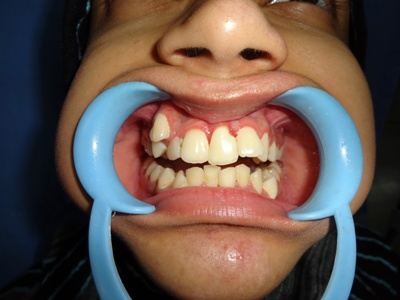
Showing Internal Resorption
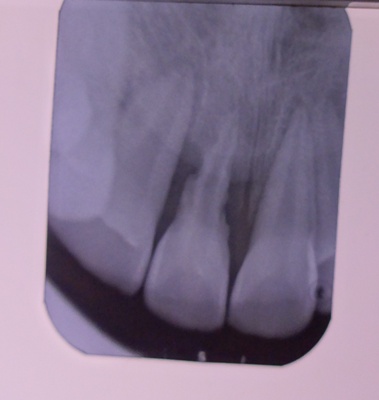
Clinical Procedure
Before extraction, upper and lower arch impressions were made with irreversible hydrocolloid and casts were prepared. The affected tooth was removed from the cast and its borders are rounded, to simulate extracted socket [Table/Fig-3]. The tooth was extracted and it was thoroughly cleaned with saline [Table/Fig-4]. The tooth was de-coronated to the level of cemento-enamel junction. The pulpal remanents were removed by using hydrogen peroxide and sodium hypochlorite and they were disinfected with glutaldehyde..Mechanical undercuts were made on the tissue surface of decoronated tooth, as there wouldn’t be chemical bonding between the extracted natural tooth and denture base resin [Table/Fig-5]. An immediate partial denture was fabricated by using patient’s own natural tooth [Table/Fig-6]. After the control of bleeding and initial clot formation [Table/Fig-7]. the finished and polished immediate partial denture was placed in position [Table/Fig-8]. Patient was recalled after 24 hours for necessary adjustments and checkup [Table/Fig-9].
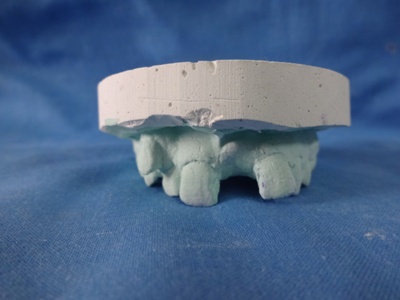
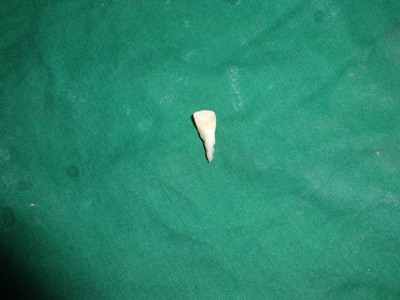
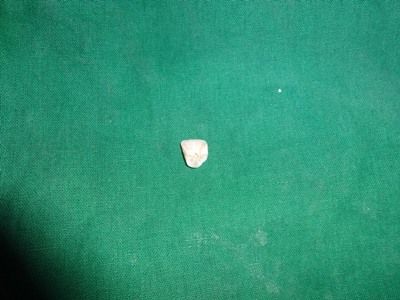
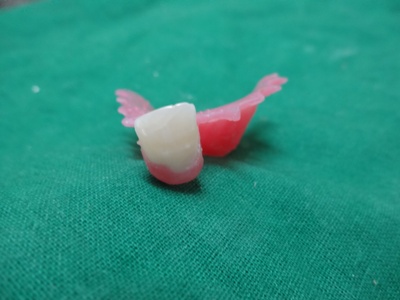
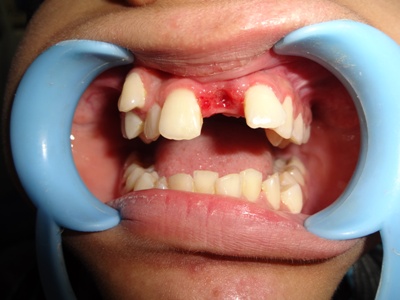
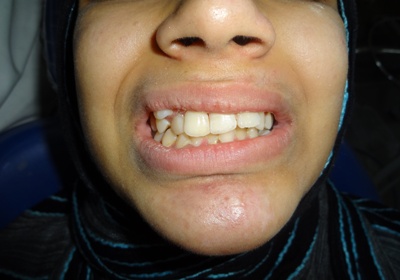
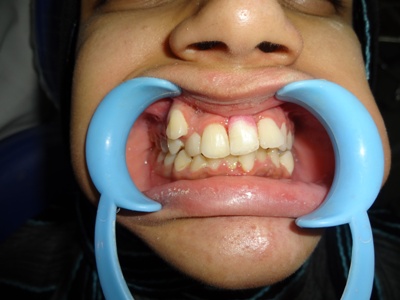
Discussion
Improvement in the interim denture procedure in the past decade, has been one of the significant advancements in prosthodontic practice [1]. Immediate dentures can minimize changes in the patient’s appearance, that can occur when natural teeth are removed. Immediate dentures provide continual support, the tongue, lips, and cheeks will not change their positions [2] and they allow patients to continue their social activities without being in an edentulous state. This process will help in avoiding the embarassment of appearing in public without teeth. It is easy to fabricate immediate partial dentures with patients’ own natural teeth, as only a least modification is required. This technique is practical and economically feasible, less laboratory work and materials are required, and it can be accomplished in a single appointment. The advantages of this technique are that there are less occlusal adjustments and that it is aesthetically excellent. Immediate dentures act as splints which help in controlling bleeding, promote rapid healing and protect against trauma from the tongue, food or teeth, if they are present in the opposing arch [3]. Sometimes, anatomical variations can make difficult the realization of a satisfactory prosthesis and/or the insertion of this immediate removable prosthesis. In these cases, surgical alveoloplasty and reshaping of alveolar ridges are required [4]. The 10% gluteraldehyde and 5.25% sodium hypochlorite disinfection reduces and removes the contamination and it prevents future bacterial growth [5]. The brittleness and strength of the natural extracted teeth is main concern in the long term use of this technique. The patient’s old FPD can be used to fabricate an immediate denture that reduces the risk of brittleness and discolouration of natural teeth [6]. The artificial tooth colour does not harmonize with the colour of the natural teeth in partial denture wearers [7]. So, aesthetically, patient’s own teeth would give best aesthetic results as compared to prosthetic teeth.
Conclusion
Immediate dentures are one option for patients who face the edentulous state, considering the excellent aesthetics and patient satisfaction with immediate denture with natural tooth is the perfect solution for a short term purpose, until underlying soft tissue and bone healing will be completed. Then, a definitive treatment plan like an implant or a fixed partial denture can be considered. With all the advantages of immediate dentures, still there are limitations of the immediate dentures, like, more office visits are required during the first few months, to watch for changes in the gums and in the mouth function. Because of changes in the tissues after removal of the teeth, immediate dentures usually need to be re-fitted by a dentist within several (usually six) months. This involves additional expenses. Also, the original good fit and occlusion of the denture will be lost as healing takes place. A proper follow-up care is essential, for the success of immediate dentures. As we followed this this approach, the patient could avoid the social stigma of appearing without teeth and she was satisfied with the final results.
[1]. Smith DE, Interim dentures and treatment denturesDent Clin North Am 1984 Apr 28(2):253-71. [Google Scholar]
[2]. Heartwell C, Salisbury FW, Immediate complete dentures: an evaluationJ Prosthet Dent 1965 15:615-24. [Google Scholar]
[3]. Jaini Jl, Immediate Denture with Unusual Bone Morphology: A Clinical ReportIAJD 2011 2(1) [Google Scholar]
[4]. Jivanescu Anca, Marcauteanu Corina, Bratu Dorin, Immediate complete denture: a case reportTMJ 2003 53(3-4) [Google Scholar]
[5]. Lolayekar Nikita V, Bhat Vidya S, Bhat Sham S, Disinfection Methods of Extracted Human TeethJ Oral Health Comm Dent 2007 1(2):27-29. [Google Scholar]
[6]. Gooya A, Ejlali M, Adli AR, Fabricating an Interim Immediate Partial Denture in One Appointment (Modified Jiffy Denture). A Clinical ReportJ Prosthodont 2012 Dec 20 [Google Scholar]
[7]. Ueda T, Color differences between artificial and natural teeth in removable partial denture wearersBull Tokyo Dent Coll 2010 51(2):65-68. [Google Scholar]